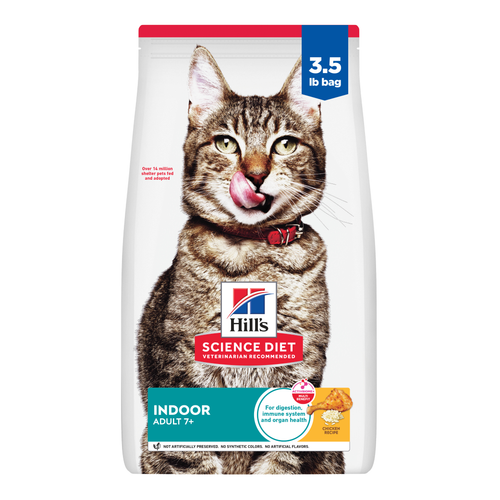

No matter your cat's age, it's important to familiarize yourself with common feline health concerns so you can understand what to look for and how to best care for your cat in the long term — whatever life brings. This includes chronic kidney disease, which affects an estimated 20% to 50% of cats over the age of 15 in some form, from stage 1 kidney disease to advanced kidney disease.
By learning to recognize signs of kidney disease in cats and understanding how proper nutrition, early diagnosis and treatment can support your cat's health, you can rest assured you're doing everything you can to help them live their best life.
All About Kidney Disease
Kidney disease, also called renal disease, refers to the loss of kidney function. The kidneys' job is to filter waste products out of the blood while retaining appropriate levels of water and salts. When the kidneys are
diseased, waste builds up in the bloodstream and increased amounts of water passes through the kidneys resulting in an increase in urination. This decrease in kidney function can lead to other medical concerns, such as high blood pressure or anemia. Kidney disease can be chronic (slow and long term) or acute (sudden) in onset.
Stage 1 kidney disease is the first level of chronic kidney disease in cats, and it's the earliest your cat can receive a diagnosis. At this point, it's unknown what causes some cats to develop kidney disease and not others. But age, genetics, certain viral infections, nutrition and dental disease are all risk factors.

Signs
Signs of kidney disease in cats can be easy to overlook, especially in its early stages. Stage 1 kidney disease is progressive, so it can advance quietly for years until your cat shows signs. Indicators of kidney disease may include:
Weight loss
Increased thirst
Vomiting
Constipation (and sometimes diarrhea)
Increased urination
Decreased energy or increased sleeping
Unkempt coat, with or without dandruff
Decreased appetite
Bad breath
If you notice any of these signs or simply notice a change in your cat, schedule an appointment with your veterinarian. Keep in mind that litter box and elimination habits can be difficult to recognize, especially in multi-cat households.
Diagnosis
Maintaining regular vet visits is the best way to catch feline diseases early. During a physical exam, your vet performs a complete check of your cat including (but not limited to) evaluating your cat's overall muscle tone, heart rate, skin and fur condition, oral health and presence of advanced disease. They'll also evaluate kidney size, symmetry and texture and examine your cat's eyes. All of these measures can provide clues about your cat's kidney health. In addition to a physical exam, your vet may also test your cat's blood and urine to screen for kidney disease.
Screening Tests
During your cat's routine wellness screening, your vet tracks levels of various markers on a biochemistry panel including blood urea nitrogen (BUN), creatinine, important electrolytes and other substances. They also regularly perform a urine test that measures the kidneys' ability to concentrate urine, called a urine specific gravity.
Another test that measures the ratio of protein to creatine in the urine can also provide valuable information about kidney health. This test isn't always offered with routine screenings; however, it is considered to be a very useful test for evaluating kidney function. If your vet recommends it, it can be worth the extra cost.
SDMA
A more recent innovation, the IDEXX SDMA is a kidney biomarker specific to kidney function that supports early diagnosis. If available to your vet, they may be able to use this tool in combination with standard blood and urine tests to catch kidney function decline as early as possible.
Nutritional Management
There's no cure for kidney disease, but nutrition is often considered a key factor for managing cats with kidney disease. Most of the time, an ideal food for affected kitties isn't acidified and is lower in protein, sodium and phosphorus. However, this recommendation may vary in early Stage 1 cats. Your vet can help you find the right food to support your cat's health, from early disease stage foods to advanced support meal plans.
Maintaining adequate hydration is also paramount. Recirculating water fountains, multiple water stations that are easy to access and rotating the placement of water bowls can encourage proper hydration; Wet food can also increase water intake. In some cases, your vet may recommend your cat as a candidate for regular fluid therapy, either in a veterinary hospital or at home. They'll also closely monitor your cat's blood values to make sure they're healthy and balanced.

Tips for Additional Support
In addition to ensuring proper nutrition and hydration, here are some other tips to support your cat's health:
Follow up on treatment for other commonly occurring diseases or consequences of kidney failure, such as anemia or high blood pressure.
Track your cat's weight with a gram scale, as this is an important indicator of overall health.
Warm food before serving to help entice picky eaters.
Help with grooming and give your cat plenty of TLC.
Follow your vet's recommended testing to track disease progression, support treatment and ensure the best possible quality of life.
Stage 1 kidney disease in cats isn't easy to detect at home, and it often goes unnoticed at first. But by educating yourself, you can do your part to help catch any potential health concerns as early as possible. Close monitoring, early intervention and active treatment all go a long way to giving your cat a happy, healthy life.























